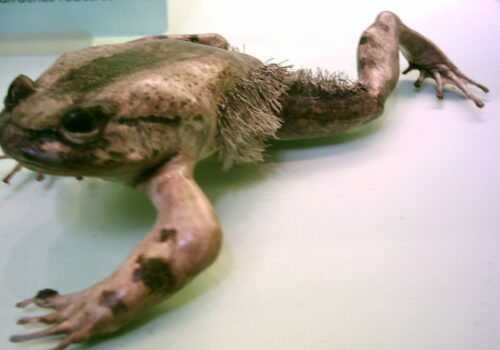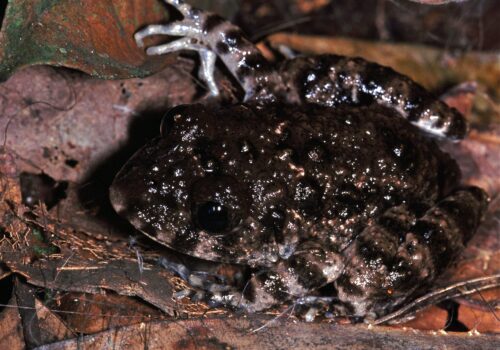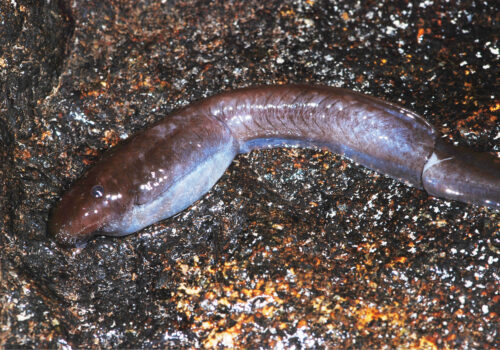- Unlocking the Secrets of Leptopelis zebra: Africa's Enigmatic Zebra Tree Frog
- Taxonomy and Classification: Understanding the Zebra Tree Frog's Lineage
- Natural Habitat: Home Within the Mist-shrouded Rainforests
- Physical Characteristics: Captivating Camouflage in Stripes
- Behavior and Life Cycle: Voices Echoing Amongst Treetops
- Ecological Role: Small Frog, Significant Impact
- Threats and Conservation Status: A Fragile Existence Amid Growing Pressure
- Cultural and Scientific Significance: Beyond Biology
- Conclusion: Listening to a Vulnerable Voice
Unlocking the Secrets of Leptopelis zebra: Africa’s Enigmatic Zebra Tree Frog#
Under the lush canopy of Central African rainforests, cloaked in a symphony of emerald green and hidden shadows, lives a striking amphibian with an appearance as captivating and unusual as its name. Leptopelis zebra—commonly known as the Zebra Tree Frog—graces its arboreal kingdom clad in delicate stripes reminiscent of the majestic African zebra. Yet despite its unique beauty, this hauntingly beautiful frog species remains relatively unknown, quietly thriving in habitats equally enchanting and fragile.
In the world of amphibians, frogs often become overlooked, overshadowed by charismatic megafauna like elephants, lions, or gorillas. However, the presence and health of frog populations like Leptopelis zebra offer crucial insight, serving as fragile messengers narrating detailed stories about environmental health, biodiversity, and conservation. Stepping into the mysterious world of the Zebra Tree Frog promises not only stunning visual delights and evolutionary intrigue, but also critical lessons we must heed if we aspire to preserve our rich natural heritage.
Taxonomy and Classification: Understanding the Zebra Tree Frog’s Lineage#
To better appreciate Leptopelis zebra, it’s essential to first explore its scientific lineage. Classified within the family Arthroleptidae, Leptopelis zebra belongs to a larger genus called Leptopelis, a diverse assemblage known collectively as African tree frogs or forest frogs. Within this genus dwell approximately 50 different species, each uniquely adapted to varying niches across a wide range of ecosystems.
Described scientifically for the first time by Amiet in 2001, Leptopelis zebra quickly gained attention due to its visually striking pattern, which sets it apart distinctly from closely related species. Its name, “zebra,” aptly references the bold banding present on the frog’s limbs and body—an evolutionary adaptation whose precise function still sparks curiosity and debate among biologists.
Despite sharing its genus with other arboreal frogs across Africa, Leptopelis zebra is unmistakably unique, adaptively fine-tuned to the ecology of its limited geographic home in Cameroon’s lush montane forests. Its close relatives, such as Leptopelis vermiculatus and Leptopelis uluguruensis, also sport intriguing appearances but differ significantly in their forest habitats, behaviors, and vocalizations.
Natural Habitat: Home Within the Mist-shrouded Rainforests#
The heartbeat of Leptopelis zebra pulses within a geographically limited sanctuary: the pristine montane forests of southwestern Cameroon—an ecological hotbed endowed with an extraordinary richness of plant and animal life. Here, enveloped by persistent tropical moisture, clouds unfurl daily, delicately embracing treetops crowned with verdant leaves and woven with trailing vines that spiral gracefully toward the nurturing earth below.
Within this atmospheric beauty emerges the Zebra Tree Frog, choosing elevations between 720 and 1,600 meters above sea level. These montane forests provide a critical habitat featuring cool, moisture-laden environments. Trees stretch high above dense undergrowth rich with ferns, mosses, and countless plant species interlinked in intricate ecological unity. Such an environment ensures the frog thrives unseen, carefully concealed within leafy shelters far above the forest floor’s damp mosaic.
An Arboreal Specialist Adapted to its Surroundings#
Life in the tree canopy poses unique challenges, deftly navigated by Zebra Tree Frogs due to remarkable evolutionary adaptations. The frog’s slender limbs and tactile toes bear specialized adhesive pads enabling it to deftly cling to slippery leaves and branches. Coupled with a secretive, nocturnal lifestyle, these physiological marvels equip this elusive amphibian to peacefully coexist amid relentless tropical rains and bustling forest life.
Poised and adept, the Leptopelis zebra exhibits particular preferences for microhabitats in forest clearings near slow-moving streams and marshy areas. These essential water bodies emerge as critical for breeding, their gentle whispers enticing mature frogs to descend from the foliage during rainy spells, signaling an eagerly anticipated reproductive season.
Physical Characteristics: Captivating Camouflage in Stripes#
The Zebra Tree Frog captivates immediately through beautifully patterned skin, marked distinctly with rich chocolate-brown bands juxtaposed upon creamy or pale green backgrounds. Its pronounced, zebra-like patterning adorns both its robust limbs and back, lending this amphibian a strikingly graphic appearance rivaled by few other species in the natural world.
Adults measure approximately 3.5 to 5 centimeters in length, embodying modest size combined with bold coloration. Their delicate faces showcase large, expressive eyes tinged bronze or golden—an adaptation reflective of their nocturnal behaviors, finely honed to detect subtle movements of prey, predators, or mates in dim, moonlit forest interiors.
Interestingly, color patterns of Leptopelis zebra provide more than aesthetic admiration, functioning as sophisticated camouflage amidst its habitat’s interplay of shadow and leaf-filtered sun rays. This morphological mastery not only offers protection from predatory birds, snakes, and small mammals but also assists ambush predation tactics employed by frogs patiently awaiting passing insects.
Behavior and Life Cycle: Voices Echoing Amongst Treetops#
As twilight descends over the Cameroonian forests, tranquility succumbs to melodious symphonies orchestrated mostly by amphibians and insects. Amongst this impressive nighttime chorus emerges the soft yet distinctive call of the Zebra Tree Frog. Emanating from males perched confidently above potential breeding sites, their vocalizations carry gently through humid air—a distinctive, quiet “tok… tok” call, rhythmic and melodic.
Breeding Rituals, Tadpoles, and Transformation#
The onset of rainy seasons triggers an intricate dance of courtship, calling from elevated perches to attract receptive females below. Females, drawn toward these calls, select mates based upon both vocal quality and territory. Once pairs unite, they descend near wetland habitats where eggs are carefully laid in hidden foliage, over water bodies—a strategy safeguarding eggs from specific predators.
Following hatching, tadpoles emerge, dropping gently into streams or pools below—vital nursery habitats teeming with available food sources and security. These tadpoles undertake a slow, meticulous metamorphosis, transitioning gradually into their elegant adult form. This metamorphosis embodies nature’s magical processes: limbs sprout, tails dissolve, and tadpoles transform into terrestrial explorers, ascending trees where they eventually mature in preparation for the continuation of their lifecycle.
Ecological Role: Small Frog, Significant Impact#
However modestly sized, Leptopelis zebra fulfills crucial ecological responsibilities within its lush forest domains. As both predator and prey, it crafts substantial ripples throughout intricate food webs. Its diet predominantly consists of insects and other small invertebrates, thus significantly influencing local insect populations and directly impacting forest pest control.
Concurrently, the Zebra Tree Frog itself provides nutrition for larger predators, including snakes, birds, and mammals, solidifying its key ecological niche in complex jungle ecosystems. Moreover, amphibians are renowned as indicators species, elucidating signs of ecosystem health or decline—early sentinels alerting biologists and conservationists to impending environmental distress.
Threats and Conservation Status: A Fragile Existence Amid Growing Pressure#
Sadly, despite their ecological importance, Zebra Tree Frogs face an uncertain future shaped primarily by habitat destruction, climate change, and localized pollution. Habitat alteration and deforestation, spurred by expanding agriculture, logging practices, and human settlements, continually erode crucial canopy habitats required by these frogs for survival and reproduction.
Currently listed by the International Union for Conservation of Nature (IUCN) as “Vulnerable,” the Leptopelis zebra requires immediate attention through dedicated conservation measures. Ensuring protected areas remain intact, managing forests sustainably, and maintaining river basin health are paramount to safeguard this charming amphibian’s continued survival.
Cultural and Scientific Significance: Beyond Biology#
Beyond ecological roles, amphibians often occupy positions of cultural reverence, symbolism, or lore within indigenous cultures. Local communities possess a deep-rooted reverence for forests that support amphibians like the Leptopelis zebra, recognizing these animals as indicators of ecosystem health and vitality.
Scientific community values frogs tremendously too—research continually discovers insights from these amphibians, related to novel compounds with medical potential, evolutionary adaptations, and critical ecosystem indicators influencing broader climate studies.
Conclusion: Listening to a Vulnerable Voice#
Leptopelis zebra—a modestly sized, brilliantly striped inhabitant of the Cameroonian rainforest canopy—is more than merely a curious amphibian stranger. Its quiet presence stands testament to nature’s remarkable evolutionary processes and highlights humanity’s responsibilities as stewards of ecological wealth. By protecting species like the Zebra Tree Frog, we safeguard not only these fragile creatures but countless intertwined networks essential for global biodiversity.
Embracing curiosity, increasing conservation action, and advocating for sustainable practices grant hope for this striking amphibian’s future. Let our awareness of the Leptopelis zebra inspire vibrant conservation conversations, meaningful actions, and appreciation for the richly woven tapestry of life we are privileged, and tasked, to protect.










